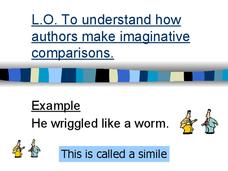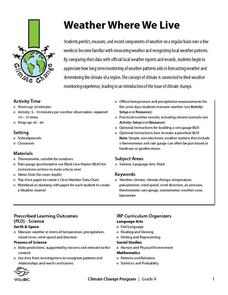Curated OER
Ice Cream: a Taste of Science!!
High schoolers define the term solution. They explain conservation of energy and energy transfer as it relate to how the milk solution became ice cream. Students are able to explain freezing point depression.
Curated OER
Vocabulary Multiple Choice- Worksheet 18
In this ESL advanced vocabulary learning exercise, students read 10 sentences that have a missing word. From 4 choices of similar words, students select the correct word to complete each sentence.
Curated OER
The Magical World of Russian Fairy Tales
Students read several fairy tales of Russian origin. They brainstorm common elements of a fairy tale and identify those elements in several examples. They retell a favorite fairy tale through a skit, oral storytelling, a sketch, or a...
National Endowment for the Humanities
The World of Haiku
Students complete a study of Japanese culture through haiku. They read and interpret haiku poetry and write haiku of their own.
Desert Discovery
Saguaro Seasons
Elementary schoolers take a look at how the saguaro cactus adapts to the four seasons of the year. This amazing plant has distinct flowering and fruiting cycles within the summer season, and other cycles during the other seasons. Your...
Curated OER
Does cloud type affect rainfall?
Student use MY NASA DATA to obtain precipitation and cloud type data. They create graphs of data within MY NASA DATA. Students compare different cloud types, compare precipitation, and cloud type data They qualitatively describe graphs...
Curated OER
Point- vs. Non-point Pollution
Students differentiate between point and non-point pollution and determine how the different types of pollution are harmful to aquatic ecosystems. They complete a series of tests on a sample of "polluted" water and a sample of "pure" water.
Curated OER
Trite Expressions Worksheet 1
In this grammar instructional activity, students read twenty sentences to find the trite expression in each one and then think of a creative way to rephrase it.
Forest Foundation
Forest Watersheds
Where does the water we use come from? To understand the concept of a watershed, class members study the water cycle and then engage in an activity that simulates a watershed.
Curated OER
Estimate How Many Seeds Are In a Fruit or Vegetable
Help mathematicians estimate how many seeds are in a given vegetable or fruit. They are divided into pairs and estimate the amount of seeds in a whole fruit without seeing the inside. They then cut the fruit or vegetable in half and...
Curated OER
Synonyms - How Authors Make Comparisons
A very good 13-slide presentation on similes and metaphors is here for you. It introduces young poets to each term, gives examples, and prompts them to work together to identify similes and metaphors in several different sentences.
Curated OER
Synonyms
Similes and Synonyms are the focus of this language arts presentation. After being introduced to similes and how they work, young writers practice writing similes about the sun by using phrases such as, "The sun is like a golden ring...
K12 Reader
An Adverb Can Tell Where
Outside, backwards, far. Adverbs that tell where action is happening is the focus of a colorful one-page worksheet that asks kids to select the appropriate adverb from the provided word bank.
Curated OER
Finding the Main Idea
Thar she blows! An excerpt from Herman Melville’s Moby Dick provides the text for an exercise in finding the main idea. After recording the main idea of the passage, readers also provide two supporting ideas. An answer key is provided.
Wild BC
Weather Where We Live
Over a span of two weeks or more, mini meteorologists record weather-related measurements. What makes this particular resource different from others covering similar activities are the thorough details for the teacher and printables for...
Oklahoma State Department of Education
Narrative Prompt
Reading about history is nothing like experiencing it firsthand. Encourage your eighth graders to do the next best thing with a historical narrative prompt, in which they describe the experience of a first-time traveler on the...
DePaul University
Seasons on the Prairie
Fact and opinion passages inform readers about the seasons on the prairie and Zambia in Southern Africa. Then, test scholar's knowledge with multiple choice and short answer questions.
K5 Learning
The Best Vacation Ever
Hang ten with a fun reading activity about a family vacation on a cruise. Fifth graders read along as Scott transfers his snowboarding skills to surfing in an engaging reading activity that includes six comprehension questions.
Chicago Botanic Garden
Weather or Not
What is the difference between weather and climate? This is the focus question of a lesson that takes a deeper look at how weather data helps determine climate in a region. Using weather and climate cards, students decide if a statement...
K5 Learning
The Coat
The moral of the story: listen to your parents! A concise reading passage introduces learners to Tom and the consequences of his choice to go out without a coat.
Colorado State University
How Does the Earth Cool Itself Off?
Where does all the heat go when the sun goes down? An interesting lesson has learners explore this question by monitoring the infrared radiation emitted over time. They learn that hot spots cool more quickly that cooler spots.
Curated OER
Complete the Story
In this story worksheet, students fill in the blanks to a story about Christmas with words from a word bank. Students fill in 13 blanks total.
Curated OER
Valentine Handprint Poem
Students make a handprint underneath a Valentine poem to give to their parents. In this Valentine poem lesson plan, students also glue conversation hearts around the edge of the page for a border.
Curated OER
Up in the Air
Students evaluate the impact of volcanic ash on the surroundin environment. Through discussion, videos and activities, they identify the various ways in which volcanic ash can be more detrimental than volcanic magma and lava.

























